Artist Aaron Kramer’s handcrafted Santa Monica home
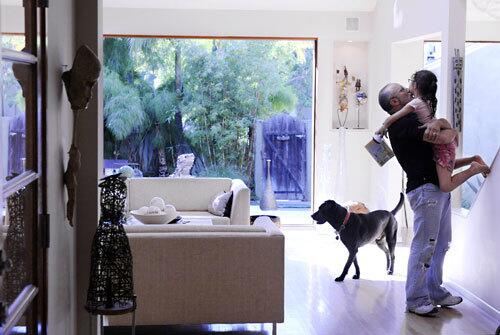
Aaron Kramer has a simple credo: “Trash is the failure of imagination.” The artist, who works with found objects and castoffs, applied that philosophy to the renovation and decoration of his Santa Monica home. Plunked between a 1930s movie star mansion designed by Richard Neutra and a residence by contemporary architect Melinda Gray, Kramer’s 1936 house was, he says, “a mish-mash, a blend of Cape Cod cottage with a little Santa Fe flair and
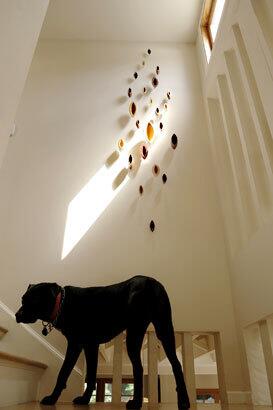
Wall-mounted “boats” have been pieced together from sections of wooden salad bowls and mounted on a staircase wall. (Mariah Tauger / Los Angeles Times)
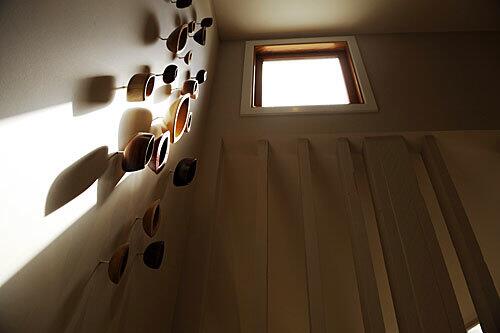
Another view of the boats. The artist, the subject of a show at the Craft and Folk Art Museum in
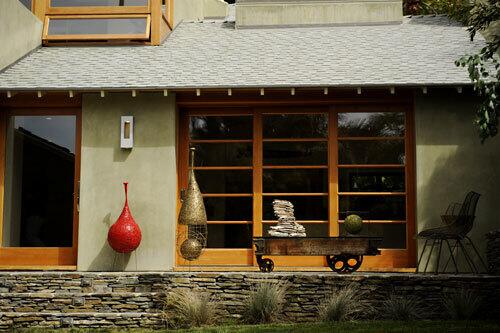
Kramer and wife Joan pushed the recessed front door forward and replaced a bay window surrounded by clapboard with sliding doors, unifying the façade into one sleek plane. As part of our “Interior Monologue” series of home profiles, we’ve paired photos with an edited commentary by Kramer, in his own words … (Mariah Tauger / Los Angeles Times)
Advertisement
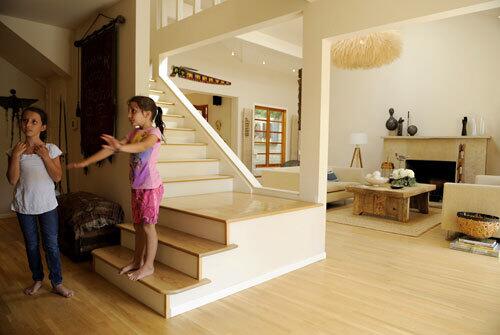
In Kramer’s own words:
The stairs have this funny crooked landing and turn away from the front door. It took awhile to get used to it, but now it’s the heart of the house. It’s where we sit and talk when we first get home. The hanging light in the center of the room was a
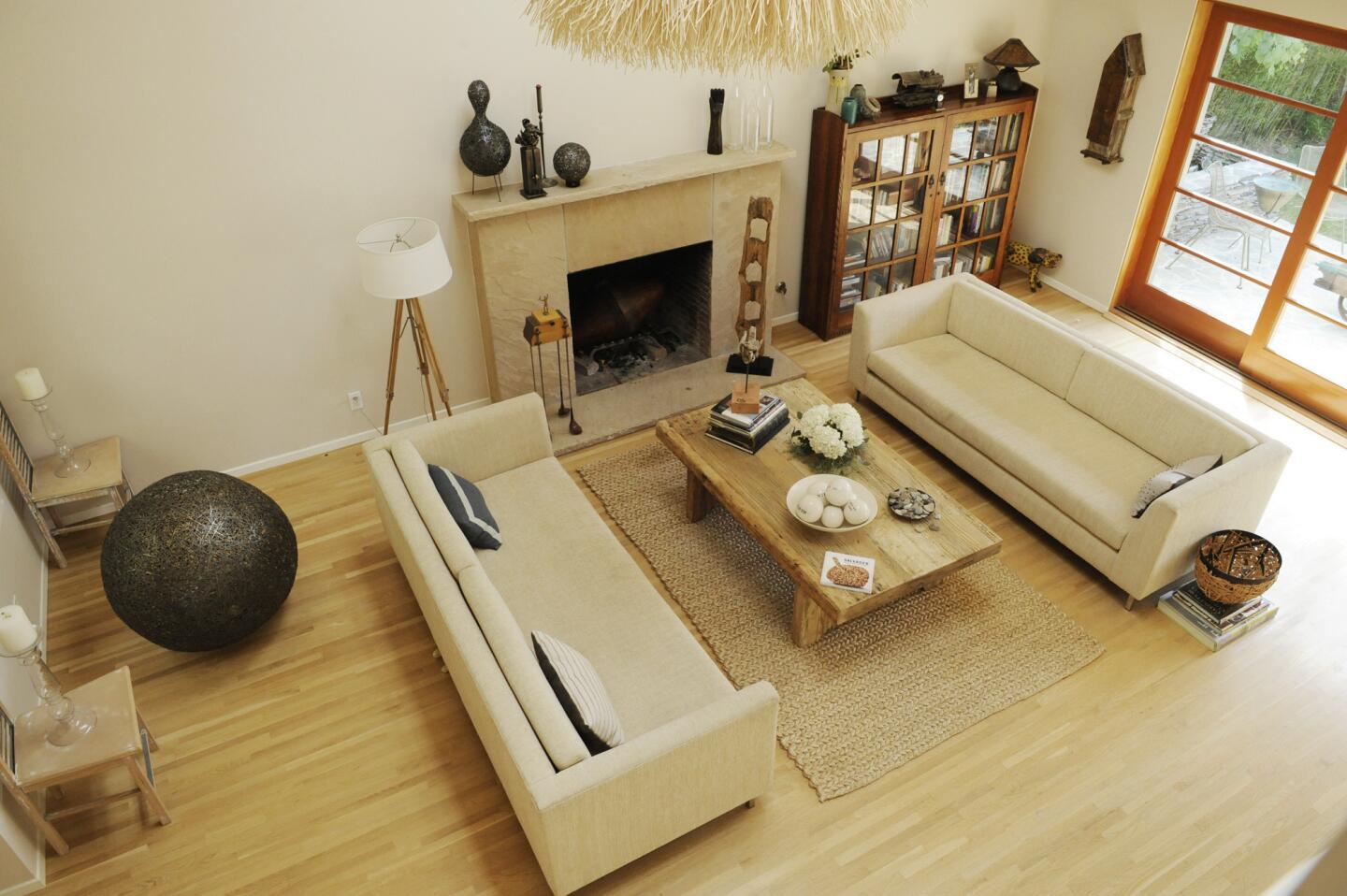
Living room: That’s one of my spheres [at left] that are made from reclaimed metal bristles used on street-sweeping machines. It sits between two tall ladder-back chairs that were display fixtures at Carson Pirie Scott in Chicago. The surveyor’s lamp came from the Wisteria catalog, the couches were custom made at the Sofa Co. on Lincoln in Santa Monica but still under $1,000 each, and my wife doggedly found the reclaimed wood coffee table on the Internet. She’s quite a good shopper. (Mariah Tauger / Los Angeles Times)
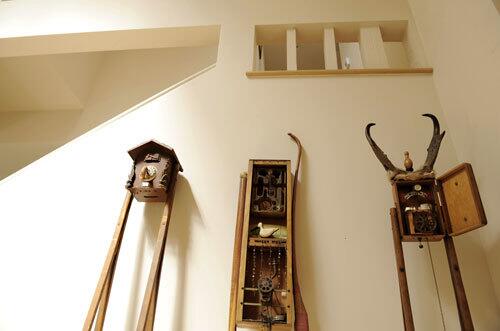
The staircase has cutouts so that you can see the living room as you ascend. On the wall in front, I put three kinetic sculptures that I made in the 1990s. The center one is made from an archery bow, and the other two are made from vintage crutches. The one on the left is a motorized cuckoo clock. (Mariah Tauger / Los Angeles Times)
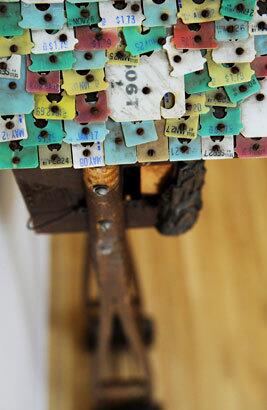
The cuckoo clock is made from a lot of different materials, including an old ruler and a piece of vintage molding from the
Advertisement
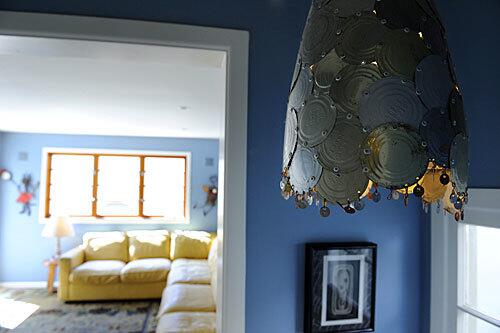
In 2002, I went to a design camp in
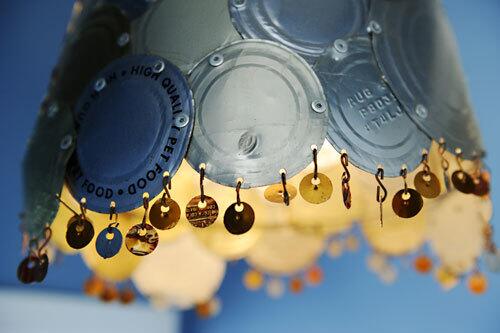
For this prototype, I welded a wire frame and then made this lampshade that slipped on top of it. It was made from different tin can lids, including one that said “quality pet food,” slightly bent and connected with pop rivets. The beads were punched-out circles from a metal sign that I attached with little wire “S” hooks that I made by hand. (Mariah Tauger / Los Angeles Times)
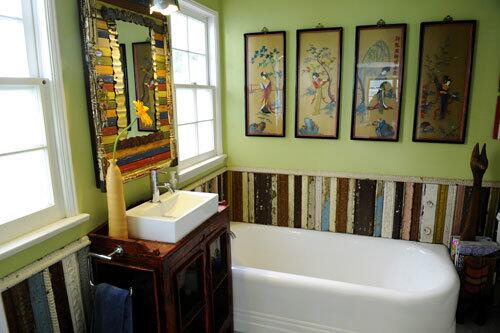
Powder room: I made the wainscoting out of molding and trim pieces that were pulled out of old homes in Chicago. I like the way the old paint on each piece complements the mirror by the artist Kathryn Arnett. The four Chinese panels above the tub came from a restaurant where my wife and I used to go when we started dating. My brother found the wash basin at Out of the Closet for $15, and I added a
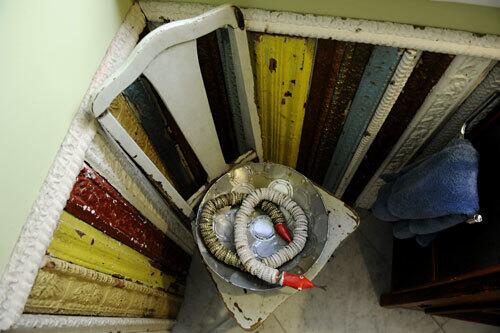
I was designing the interior of a store in
Advertisement
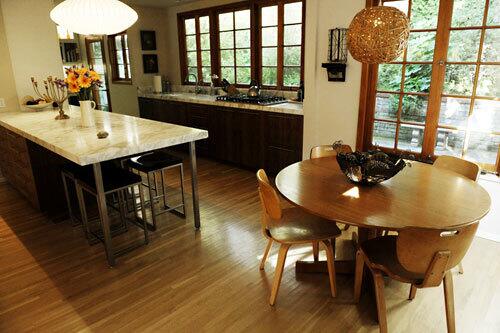
My mom was an interior designer at a store that sold Scandinavian furniture in Chicago, and this is her old wooden table. We had two vintage Thonet chairs with cut-out handles and got two contemporary Thonet chairs to go with them. I made the lamp above from recycled coffee stirrers. They cost $395 at the Craft and Folk Art Museum, but I show people how to do it at a workshop at the Urban Crafts Center in Santa Monica. The counter is another bang-for-your-buck idea. We got a slab of Calcutta Gold marble only ¾-inch thick but put a 2-inch-thick lip around the edge, which gives you a massive feel done cheaply. (Mariah Tauger / Los Angeles Times)
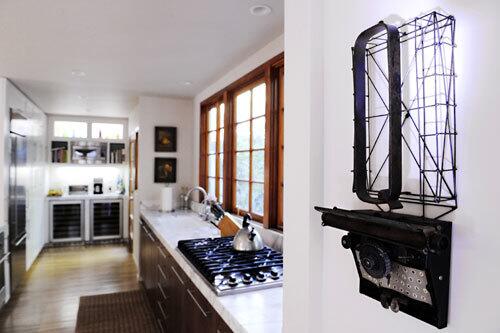
The sculpture on the right is called “Q.” I made it from a toy typewriter and a letter Q from an old sign connected by a wire frame that I fabricated. (Mariah Tauger / Los Angeles Times)
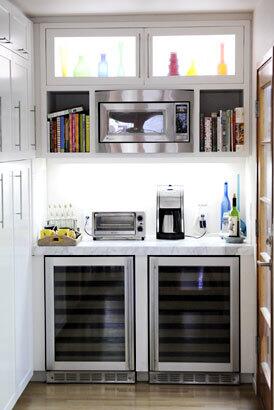
My wife designed the kitchen, and all the cabinetry that you can only see when you are in the kitchen is painted white. On the other side, we used walnut doors, so you can see the expensive stuff from the living room and dining room. The colored bottles on the top shelf above the cookbooks and microwave look like they are illuminated by a window, but that’s a trick. It’s just fluorescent lighting. (Mariah Tauger / Los Angeles Times)
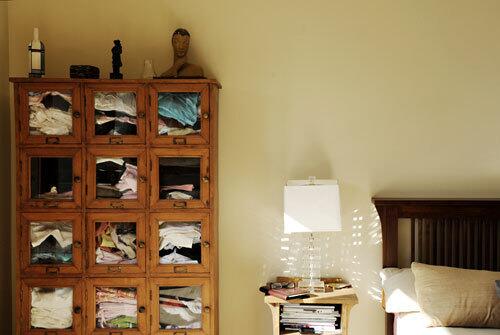
The master bedroom. (Mariah Tauger / Los Angeles Times)
Advertisement
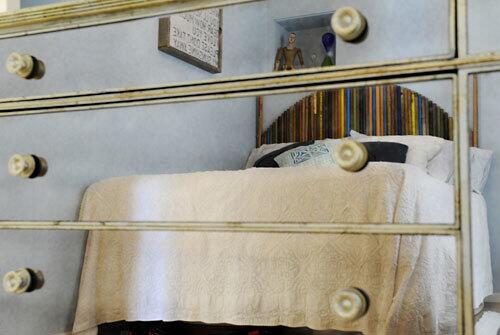
Guest room: A long time ago I observed that broom handles were always sticking out of trash cans because they didn’t fit. I was particularly attracted to the wooden ones that showed evidence of hand, so I started collecting them and cutting off the bristles. It took five years of collecting to get enough of them -- 62 screwed together on a frame -- to do the headboard reflected in a mirrored dresser. (Mariah Tauger / Los Angeles Times)
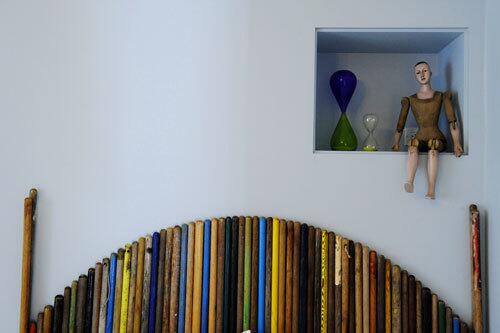
The headboard took up the whole wall, so I built a little niche above it where an alarm clock could go. (Mariah Tauger / Los Angeles Times)
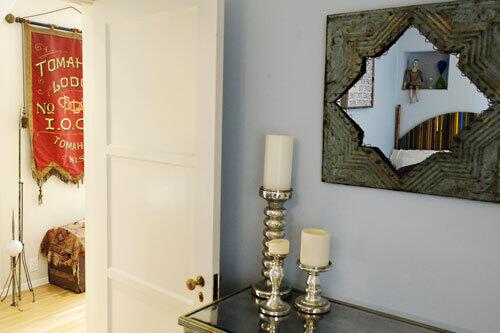
The mirror is by Kathryn Arnett, and you can see the broomstick headboard I made in it. The mirrored chest from
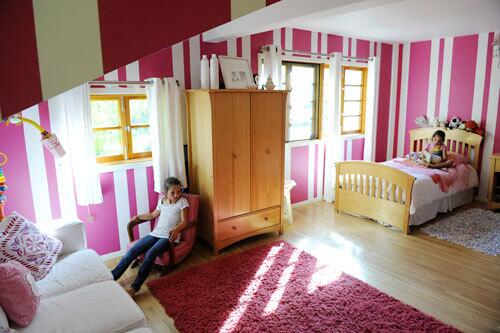
Daughters’ room: My wife said Emma, left, and Ana could pink out the paint color. My wife said, “Oh, my God, I can’t paint the whole room fuchsia,” so she created a stripe pattern: 15 inches, 5 inches, 3 inches, 5 inches, repeat. I didn’t think it was going to work at all with the sloped ceilings, but it really does. The floor lamp in the corner of the room by the vintage kids rocking chair is by artist Neil Benson, founder of Dumpster Divers of
Advertisement
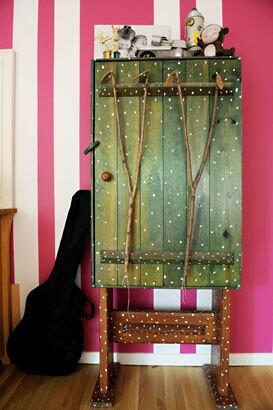
Also in the girls’ room. (Mariah Tauger / Los Angeles Times)
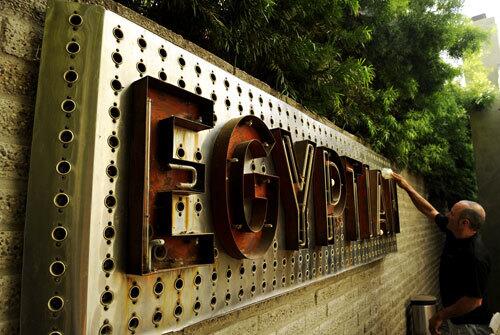
I got this old marquee in college. It came from an Egyptian Revival Art Deco movie theater in
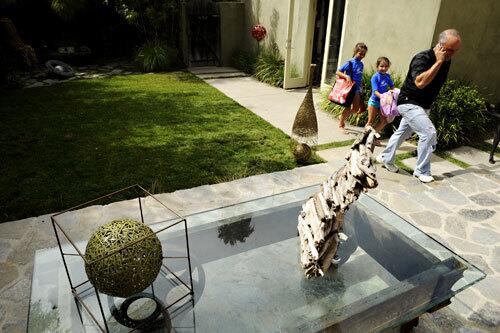
That used to be our coffee table, and my wife wanted to get rid of it. I said I loved it too much, so I rolled it outside. It’s an old livery cart with iron wheels and wooden frame for moving goods around a factory. Catalogs are selling them for $900, and I got this one off a loading dock in Chicago for free. (Mariah Tauger / Los Angeles Times)
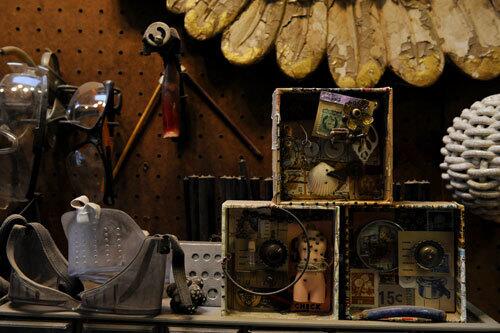
My workshop: I’ve been trash picking and Dumpster diving since I was a kid skateboarding around Chicago. Now trash has a way of finding me. I keep it organized and use it though. It’s not like I’m a candidate for “Hoarders.” (Mariah Tauger / Los Angeles Times)
Advertisement
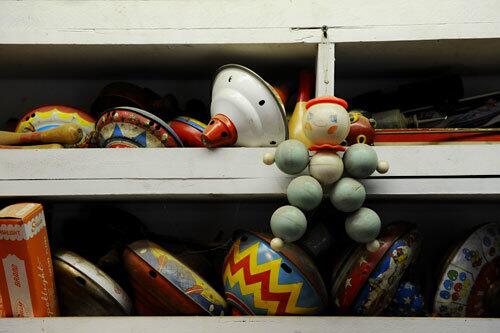
More finds. (Mariah Tauger / Los Angeles Times)



